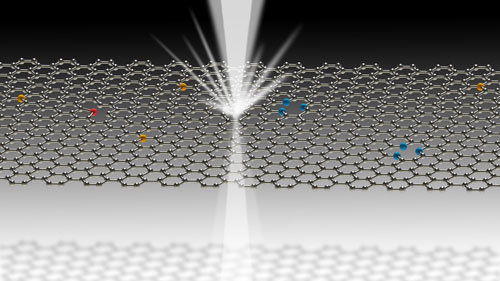| Posted: Sep 01, 2014 | |
An all-carbon optical diode for photonic computing |
|
| (Nanowerk Spotlight) Silicon transistors have been made smaller year after year, but they are approaching a point of physical limitation. Their increasingly small dimensions, now reaching well into the nanoscale, will prohibit any gains in performance due to the nature of silicon and the fundamental laws of physics. Within a few more generations, classical scaling and shrinkage will no longer yield the sizable benefits of lower power, lower cost and higher speed processors that the industry has become accustomed to (read more here about pushing the limits of silicon electronics and possible successor technologies). | |
| Carbon materials such as carbon nanotubes and graphene are heavily researched as potential replacement for silicon in electronics applications. While the present day carbon nanotechnology is well set to carry forward the scaling in size, a concomitant scaling in speed enforces the need for all-carbon photonic devices. | |
| "Carbon-based photonic technologies ostensibly lag their electronic congeners in development," Ramakrishna Podila, an Assistant Professor of physics at Clemson University, tells Nanowerk. "A key element missing in the all-carbon offering of photonic devices is the optical diode, a fundamental element in any photonic logic circuit, which allows nonreciprocal transmission of light similar to current flow in an electronic p-n junction diode." | |
| Harnessing the optical properties of graphene-based materials offers an opportunity to create the all-photonic analogs of diodes, transistors, and photonic logic gates that will one day enable construction of the first all-photonic computer. | |
| In new work, researchers at Clemson Nanomaterials Center and their collaborators at Raman Research Institute (Reji Philip) and Sri Sathya Sai Institute of Higher Learning (Benoy Anand) demonstrated the experimental realization of the first all-carbon optical diode that is ready for scalable integration along with being inherently broadband in operation with no restrictions on polarization or phase-matching criteria. | |
| The team reported their findings in Nano Letters ("Optical Diode Action from Axially Asymmetric Nonlinearity in an All-Carbon Solid-State Device"). | |
 |
|
| Graphene exhibits peculiar non-linear optical properties, which as shown by researchers at Clemson Nanomaterials Center can be used to break 'time-reversal symmetry' of light to achieve photonic diodes and photonic logic. The red, orange, and blue dots are nitrogen atoms that can dope graphene sheets in different configurations (viz., pyridinc, graphitic, and pyrrolic) to help tune its optical and electronic properties. (Image courtesy: Achyut J. Raghavendra, Clemson Nanomaterials Center) | |
| A 'passive' optical diode functioning in an all-carbon on-chip platform will be indispensable in integrated photonics for optical signal processing and signal isolation. However, such a realization is prevented by the reciprocity in light transmission i.e., 'if I can see you, you can see me too'. In a diode, light transmission is needed in one direction only. This is not trivial to achieve and necessitates breaking the inherent time-reversal symmetry of electromagnetic waves. | |
| The researcher fabricated a solid-state all-carbon passive photonic diode that achieves uni-directional light transmission by employing a saturable absorber (graphene) and a reverse saturable absorber (C60) in tandem. By engineering the fundamental differences in the non-linear optical properties of graphene and C60, they were able to break the time-reversal symmetry. | |
| "In our optical diode, we used thin-films of C60 (∼5 nm) and graphene (∼2 nm) to achieve a moderate optical nonreciprocity factor (ratio of forward to backward transmission) of ∼4," explains Apparao M. Rao, Director of the Clemson Nanomaterials Center. "Further, by varying the number of graphene layers and the thickness or concentration of C60 coating we demonstrated tunability of key nonlinear parameters that determine the nonreciprocity factor." | |
| The innovative aspect of this work is the utilization of an abrupt jump in the nonlinear absorption coefficient of two different allotropes of carbon to break the time-reversal symmetry – as opposed to traditional periodic variation of refractive index or dielectric constant. | |
| As Podila and Rao point out, the resulting all-carbon optical diode, built from a graphene and C60 sandwich structure, is passive, all-optical, polarization independent and has no phase-matching constraints. | |
| "The device organization is extremely simple, inexpensive and provides ample scope for scalability," Podila notes. "With a tunable nonreciprocity factor and potentially large bandwidth combined with its ultra-compactness (∼7nm thickness) and solid-state nature, our optical diode is promising for cost-effective large-scale integration in photonic circuits." | |
| Currently, these researchers are focusing on improving the optical/electronic properties of graphene films by doping them with nitrogen in various configurations. "We expect to increase the nonreciprocity factors of the optical diodes to >10 by changing the non-linear optical properties of graphene by doping. With ultrafast carrier dynamics of nanocarbons, especially graphene, our device could offer unprecedented speed levels in photonic logic circuits," Rao concludes with an eye for the future. | |
 By
Michael
Berger
– Michael is author of three books by the Royal Society of Chemistry:
Nano-Society: Pushing the Boundaries of Technology,
Nanotechnology: The Future is Tiny, and
Nanoengineering: The Skills and Tools Making Technology Invisible
Copyright ©
Nanowerk LLC
By
Michael
Berger
– Michael is author of three books by the Royal Society of Chemistry:
Nano-Society: Pushing the Boundaries of Technology,
Nanotechnology: The Future is Tiny, and
Nanoengineering: The Skills and Tools Making Technology Invisible
Copyright ©
Nanowerk LLC
|
|
|
Become a Spotlight guest author! Join our large and growing group of guest contributors. Have you just published a scientific paper or have other exciting developments to share with the nanotechnology community? Here is how to publish on nanowerk.com. |
|
